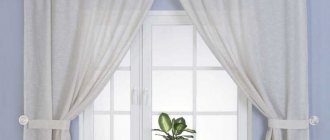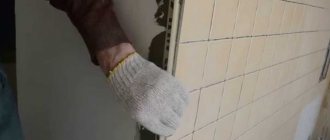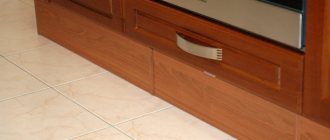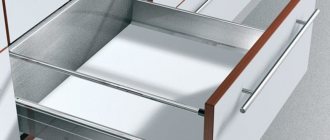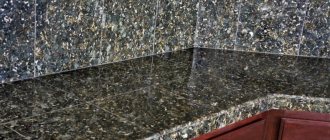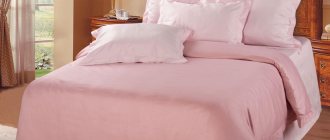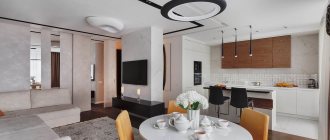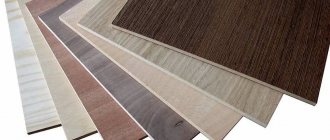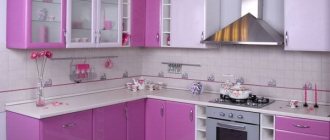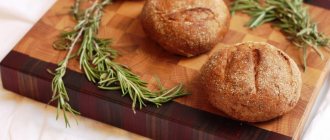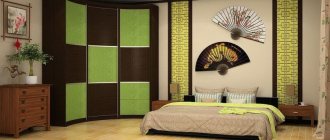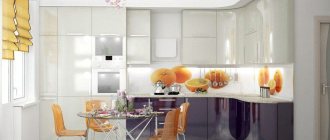The most economical option for kitchen facades is an MDF base covered with PVC film. With the help of this finishing it is possible to imitate the structure of surfaces made of veneer, solid wood or painted slabs. After all, most buyers of kitchen sets are looking for beautiful, stylish furniture, but at an affordable price. This means that the cost of producing facade slabs should be minimal. Terms vary between 7-14 days.
As a result, it turns out:
- quickly produce furniture for straight, corner, U-shaped kitchens;
- achieve beautiful lining of doors on cabinets and cabinets, drawers;
- reduce the cost of finished products.
The Facades catalog presents a selection of PVC boards with imitation wood patterns, marble structures, and 3D printed surfaces. Choose MDF in PVC film for furniture in a classic, modern, hi-tech style, based on the technical characteristics of the products (indicated in each product card). Decide on the palette, texture, milling, and prices.
Advantages and disadvantages of plastic
What's good about this material?
- Reliable and wear-resistant.
- Serves up to 25 years.
- Does not fade under the influence of ultraviolet radiation.
- Does not deform from sudden changes in temperature or humidity.
- Withstands minor mechanical impacts.
- It looks expensive and neat.
- Glossy surfaces visually expand the space.
- Can imitate other, more expensive materials.
- Not afraid of exposure to detergents (except for abrasives).
The only drawback is, perhaps, the relatively high price.
How to choose materials?
When choosing furnishings, most people start with design and quality. The appearance of the furniture continues the theme of the interior and pushes other characteristics into second place. The next issue is the durability of materials and fittings, thanks to which the furniture retains its current, fresh decor for many years.
Modern production uses solid wood, plastic, furniture boards made from natural raw materials with various coatings. The quality of furniture products and the price depend on the materials. High cost does not always automatically mean that a headset is better than others. The installation location is of great importance. Kitchen furniture requires completely different priorities in order to maintain an excellent appearance during intensive use:
- Resistant to thermal shocks.
- Reliability of the design.
- Resistant to water and active food ingredients.
- Adaptability to layout.
- Stable under high weight loads.
- Design functionality.
- Easy care.
All consumer requirements are met by MDF furniture board made from pressed crushed wood. Depending on the surface finish, the material has different characteristics and decorative capabilities.
Real reviews about MDF and plastic
To choose a suitable façade option, you need to consult with a professional, or better yet, study reviews of materials and messages on construction forums.
Option 1. PVC film + MDF
1) I think PVC is the best option. It costs much less than other materials, but still looks beautiful. Of course, I'm talking about quality, and not bought on the market. Such a kitchen will last a long time (I have had the film for more than two years and it’s still like new). It is clear that over time it will have to be replaced, but not a single material, even the most expensive, can last us a lifetime. Elena from Omsk
2) At one time we were choosing between film and plastic: they were almost identical in appearance, so we couldn’t decide. The consultant recommended the first option. We have been using this kitchen for 3.5 years now. No damage appeared during this time. The main thing is not to clean with powders or prickly brushes to avoid scratching. But plastic has the same problem. Galina from Krasnoyarsk
3) Our kitchen is combined - MDF film and enamel. In such furniture sets the differences are best visible.
The enamel is smoother and its color is richer. This is even noticeable in the photo. But the film is not so fastidious to care for. Regarding durability, there are no complaints about any of the coatings: no damage has appeared in three years. Marina from Minsk
4) The only advantage of the film is that it is inexpensive. That's all. If your plans do not include changing the kitchen in a few years, it is better to choose plastic. You can also combine two coatings: cover the main area with film, and paint the areas that are most often exposed. But we must remember that painted surfaces should be protected from impacts. And it’s best to choose an array - it’s aesthetically pleasing and durable. Milana from Saratov
Option 2. Painted MDF and enamel
1) It seems to me that it is better to choose painted MDF. It is a little more expensive than film, but also quite budget-friendly. At the same time, it lasts a long time and looks good. I would advise lovers of combined coatings to turn their attention to frame MDF. Ivan
2) We have enamel and plexiglass. For 4 years, not a single chip occurred. Enamel is easier to care for: it hardly gets dirty and is easy to wipe clean. Plexiglas, on the contrary, absorbs dirt very strongly and is not easy to clean. Now I regret that I once listened to the designer’s advice and chose such a coating. Irina
3) I believe that enamel has one significant advantage that outweighs all the disadvantages: neat corners without an edge. It doesn't smudge, it's easy to clean and looks great. Catherine
Option 3. Plastic
1) We have plastic. Looks beautiful, easy to care for. My parents have acrylic - over time, chips have appeared, and plaque appears on the upper cabinets, despite conscientious regular cleaning. Although, when purchasing, dad was assured that acrylic kitchens are the most practical. Anastasia
2) We have glossy plastic facades. The terribly inconvenient thing is that all the scratches, even the smallest ones, are visible. And relatives have enamel. There is another problem - chips. So there are shortcomings everywhere. Anton
What MDF coatings are used for kitchen furniture?
Decorative coatings for composite panels are applied using different technologies and materials:
- Postforming is a relatively new method of cladding kitchen facades from MDF. The slabs are protected by a layer of plastic, which is firmly glued to the base and provides protection from external factors. Plastic is resistant to abrasion and chemical compounds. An important difference between postforming and other lining options is the continuous surface.
- Acrylic is another plastic coating option. This decor is always glossy and bright. Minor damage can be easily removed by simple sanding.
- PVC film is an inexpensive, durable coating with wide design possibilities.
- Softforming is the decoration of a furniture board with a laminating film in several layers together with polymer resins.
Due to the peculiarities of the kitchen atmosphere, temperature fluctuations, and high humidity, the main materials for the kitchen are plastic and film.
Covering kitchen units with film at home
To successfully cover a kitchen façade or splashback with MDF at home, you need to carry out the preparatory stage correctly. It consists of the following points:
- Preparing facades for pasting. To improve the adhesion of the adhesive base to the part being restored, it must be cleaned of dust and dirt and degreased using detergents based on alcohol or quaternary ammonium. If there are deep scratches and chips, they need to be puttied.
- Preparing the walls. To stick it as a kitchen backsplash on a plastered wall or drywall, the surface of the base is puttied, sanded and coated with a primer. Painted walls are cleaned of dust and degreased.
- Preparation of materials. Before starting work, the film for the kitchen facades and apron is unrolled, the information on the back is read, and patterns are made in accordance with the marking grid and the dimensions of the parts (surfaces).
The gluing process occurs for each part separately.
The work is carried out in the following order:
- They try the pattern on the part and make sure that it fits neatly in place.
- Remove the edge of the pattern by approximately 5 cm from the protective paper. And carefully align it with the edge of the part, trying to avoid distortion.
- Gradually remove the paper backing and roll the pattern onto the surface of the facade. The principle of pasting is similar to working with wallpaper - smoothing is carried out from the center line to the edges, trying to drive the “bubbles” beyond the border of the part.
- To paste over relief parts with internal corners and edges, the film can be slightly heated with a regular hairdryer to make it more flexible and “softer”.
- If a fold or crease is formed, or if the pattern is shifted to the side relative to the axis (border) of the part, the façade film for the kitchen must be carefully separated from the surface and re-glued.
Video on how to cover a kitchen unit yourself with film below:
Watch the video of how to cover a kitchen façade with self-adhesive film with printing:
Panel finishing elements
Materials made from polyvinyl chloride and medium-density wood fiber boards for cladding wall and ceiling surfaces are produced in the form of panels of various widths, with a variety of decorative loads and surface textures. In terms of decorative properties, giving preference to one or another option seems to be quite a difficult task. This is explained simply: PVC and MDF panels have almost complete artistic identity.
The method of installation of elements made of polymer and wood fiber is also not significantly different. They are mounted on a preliminary prepared frame. This technique carries with it a certain number of disadvantages in the form of loss of room space, and some advantages: sound or heat insulating material can be laid in the frame space.
Another common advantage of PVC and MDF panels is the finish of their front surface. Walls and ceilings constructed using this material do not require additional finishing processes and are equally amenable to cleaning measures.
The environmental indicators of polyvinyl chloride and compressed wood fiber are also in balance with each other and comply with all sanitary and hygienic standards for toxic and hazardous substances released. PVC and MDF materials are even approved for use in children's and medical institutions.
Colors and texture of PVC films for furniture facades
The texture and color of the film determines the overall appearance of the furniture facade, so manufacturers have mastered the production of a huge number of different types. It can imitate natural materials, be plain or with numerous decorative designs, colorful or embossed. Thus, transparent, matte and glossy, embossed and textured, mother-of-pearl or “chameleon”, patterned or “metallic” and many other types are produced.
The color range probably includes all existing shades - from the lightest to almost black in the entire diversity of the spectrum. Coatings that imitate shagreen, silk, rare woods, genuine leather, polished natural stone, etc. look very nice.
Base for polyvinyl chloride film coating - materials and requirements
By request, the next note will be on the topic - a wall sliding wardrobe with your own hands at home with a photo. We believe you will like it.
The PVC-coated panel consists of three parts:
- basics;
- films;
- facing edges (sides).
Not every base is suitable for covering with film. Manufacturers use two types - chipboard and MDF.
Chipboard facades are more affordable, but their durability is a very controversial issue. This material perfectly absorbs moisture and swells, causing the film to begin to peel off. Moreover, the toxic resins that make up the chipboard can evaporate into the air if the integrity of the coating is damaged and have a poisonous effect on the human body and pets.
It is thanks to cheap structures made from particle board that film-based coatings have an undeserved reputation as a low-quality and unreliable material.
In theory, PVC can also be coated on panels made of beautifully sanded real wood. However, basically, the manufacturer does not strive to hide, but, on the contrary, to highlight the appearance and natural pattern; therefore, the tree is also not suitable for applying film.
Polyvinyl chloride coating is recommended for use on facades made of medium-density wood-fiber panels - an environmentally friendly and non-hazardous material with high performance characteristics. It does not change its original shape, is resistant to moisture and high temperatures, and its smooth, jagged surface reduces the risk of film peeling.
Sticking
If the surface of the facade is flat, i.e. does not have milling, an excellent solution would be to cover it with self-adhesive film. Pasting is much easier and faster than painting. The step-by-step instructions look like this:
| Illustrations | Actions |
Materials:
| |
Preparation. Before pasting the facade, you must perform the following steps:
| |
Sticking:
|
That's all the method for restoring film facades.
General finishing features
The technology for making a kitchen from both materials is basically similar. The basis of the first type of furniture is MDF (medium-density fiberboard), covered with PVC film or painted with enamel. The design of the second type of furniture includes chipboard or MDF boards with overlays applied to them, for the manufacture of which plastic is used. In both cases, the frame is first made, and then only the kitchen facades are finished.
Each material is durable, easy to care for, environmentally friendly, and not subject to destruction by ultraviolet radiation. Both options have an affordable price, a huge variety of design solutions and colors, which is not typical for expensive and prestigious solid wood furniture.
Advice! When purchasing a kitchen set, you need to pay attention to the thickness of the facades: for chipboard it should be at least 18 mm, and for painted or film-coated MDF it should be 16 mm.
